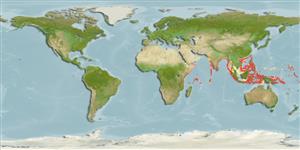Пластиножаберные (акулы и скаты) (sharks and rays) >
Carcharhiniformes (Ground sharks) >
Proscylliidae (Finback catsharks)
Etymology: Eridacnis: Etymology not explained, possibly eri-, Greek intensive particle (i.e., very), and dakno (Gr.), bite, referring to “wide, angular” mouth of E. radcliffei. (See ETYFish); radcliffei: In honor of ichthyologist-malacologist Lewis Radcliffe (1880-1950), scientific assistant of the U.S. Bureau ofFisheries and member of team that collected holytype from aboard the fisheries steamer Albatross. (See ETYFish).
More on author: Smith.
Environment: milieu / climate zone / depth range / distribution range
экология
морской батидемерсальный; пределы глубины 71 - 766 m (Ref. 10004). Deep-water; 22°N - 10°S
Indo-West Pacific: widely distributed but with spotty records from Tanzania, the Gulf of Aden, India (Gulf of Mannar, Bay of Bengal), Andaman Islands, Viet Nam, and the Philippines. The immense range of this species is striking compared to the limited ranges of other members of the genus.
Length at first maturity / Size / Вес / Возраст
Maturity: Lm 15.5, range 15 - 16 cm
Max length : 23.0 cm TL самец/пол неопределен; (Ref. 244); 24.0 cm TL (female)
колючие лучи спинного плавника (общее число): 0; членистые (мягкие) лучи спинного плавника (общее число): 0; колючие лучи анального плавника 0; членистые (мягкие) лучи анального плавника: 0. Caudal fin without a rippled dorsal margin and ventral lobe but with a strong subterminal notch; vertebral axis of caudal fin little raised above body axis (Ref. 13566). Dark brown with blackish markings on dorsal fins (Ref. 13566).
Occurs over muddy bottoms, on the upper continental and insular slopes and outer shelves (Ref. 244). Feeds mainly on small bony fishes and crustaceans, with squid a lesser item in the diet (Ref. 244). One of the two smallest living sharks (Ref. 13566). Ovoviviparous (Ref. 50449), with 1 to 2 pups in a litter (Ref. 244).
Ovoviviparous, embryos feed solely on yolk (Ref. 50449). 1-2 pups per litter, size at birth about 11 cm (Ref. 244).
Compagno, L.J.V., 1984. FAO Species Catalogue. Vol. 4. Sharks of the world. An annotated and illustrated catalogue of shark species known to date. Part 2 - Carcharhiniformes. FAO Fish. Synop. 125(4/2):251-655. Rome: FAO. (Ref. 244)
Статус Красного Списка МСОП (Ref. 130435)
Использование человеком
дополнительная информация
ссылкиаквакультура (рыбоводство)особенности рыбоводствастепень растяжениягенетикаElectrophoresesнаследуемостьболезниобработкаNutrientsMass conversion
соавторыизображенияStamps, Coins Misc.звукиCiguateraскоростьтип плаванияжаберная областьOtolithsмозгзрение
инструменты
Специальные отчеты
Скачать в формате XML
ресурсы в Интернет
Estimates based on models
Preferred temperature (Ref.
123201): 9.3 - 18.6, mean 12.7 °C (based on 254 cells).
Phylogenetic diversity index (Ref.
82804): PD
50 = 0.6328 [Uniqueness, from 0.5 = low to 2.0 = high].
Bayesian length-weight: a=0.00389 (0.00180 - 0.00842), b=3.12 (2.94 - 3.30), in cm total length, based on all LWR estimates for this body shape (Ref.
93245).
Trophic level (Ref.
69278): 4.1 ±0.3 se; based on diet studies.
устойчивость к внешним воздействиям (Ref.
120179): очень низкий, минимальное время удвоения популяции более 14 лет (Fec=1).
Fishing Vulnerability (Ref.
59153): Low vulnerability (14 of 100).
Nutrients (Ref.
124155): Calcium = 14.4 [2.4, 98.2] mg/100g; Iron = 0.371 [0.078, 1.303] mg/100g; Protein = 18.1 [16.0, 20.2] %; Omega3 = 0.235 [0.091, 0.594] g/100g; Selenium = 8.99 [2.70, 29.75] μg/100g; VitaminA = 35.1 [6.9, 180.5] μg/100g; Zinc = 0.462 [0.219, 0.922] mg/100g (wet weight);
